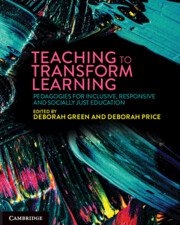Book contents
- Teaching to Transform Learning
- Acknowledgement of Country
- Teaching to Transform Learning
- Copyright page
- Contents
- Contributors
- Acknowledgements
- Introduction Understanding the learner to inform educators’ implementation of pedagogical approaches to transform learning
- Part 1 Pedagogies for all
- 1 Aboriginal pedagogies: exploring Indigenous ways of knowing, being and doing
- 2 Making lifeworld connections through critical pedagogies
- 3 Culturally responsive pedagogies: learners as assets
- 4 Traversing identities: navigating the self, school and system for culturally responsive pedagogies
- 5 Culturally and religiously responsive pedagogy: a case study of enabling pedagogy for superdiverse Australian classrooms
- 6 Enabling pedagogy and critical teaching approaches in diverse learning contexts
- 7 Pedagogy of hospitality
- Part 2 Engaging pedagogies: making the curriculum come alive for all learners
- Part 3 Empowering pedagogies: 21st-century skill development and 22nd-century futures thinking
- Index
- References
3 - Culturally responsive pedagogies: learners as assets
from Part 1 - Pedagogies for all
Published online by Cambridge University Press: 25 October 2024
- Teaching to Transform Learning
- Acknowledgement of Country
- Teaching to Transform Learning
- Copyright page
- Contents
- Contributors
- Acknowledgements
- Introduction Understanding the learner to inform educators’ implementation of pedagogical approaches to transform learning
- Part 1 Pedagogies for all
- 1 Aboriginal pedagogies: exploring Indigenous ways of knowing, being and doing
- 2 Making lifeworld connections through critical pedagogies
- 3 Culturally responsive pedagogies: learners as assets
- 4 Traversing identities: navigating the self, school and system for culturally responsive pedagogies
- 5 Culturally and religiously responsive pedagogy: a case study of enabling pedagogy for superdiverse Australian classrooms
- 6 Enabling pedagogy and critical teaching approaches in diverse learning contexts
- 7 Pedagogy of hospitality
- Part 2 Engaging pedagogies: making the curriculum come alive for all learners
- Part 3 Empowering pedagogies: 21st-century skill development and 22nd-century futures thinking
- Index
- References
Summary
Educational settings are becoming increasingly diverse including culture, gender, ability and religious beliefs. Yet, a mono-cultural approach to teaching that prioritises some learners while excluding others continues to be adopted (Morrison et al., 2019). Building on past education declarations, the Alice Springs (Mparntwe) Education Declaration (Education Council, 2019) has a strong focus on equity and social justice with goal 1 calling for ‘The Australian education system [to] promote[s] excellence and equity’. Building on this, goal 2 seeks to develop ‘confident and creative individuals; successful lifelong learners; active and informed members of the community’. If we are to meet these goals, educators need to recognise and embrace the lifeworlds of all learners and use these as platforms from which new learning can build; something that is at the heart of culturally responsive pedagogies (CRP). This chapter argues that educational approaches founded on pedagogies that draw on learner’s lifeworlds, lived experiences and funds of knowledge (Zipin, 2009), foster enhanced educational engagement, achievement and wellbeing.
Keywords
- Type
- Chapter
- Information
- Teaching to Transform LearningPedagogies for Inclusive, Responsive and Socially Just Education, pp. 42 - 59Publisher: Cambridge University PressPrint publication year: 2024

